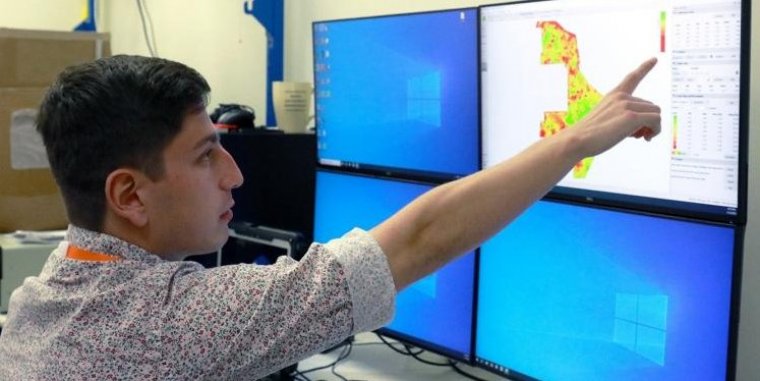| News / Science News |
'Storytelling' plants may help find human remains
When someone disappears in an area of dense vegetation, search and recovery efforts can be difficult, especially when a missing person’s last location is unknown.

Jack Orebaugh shows the map of the University of Tennessee Anthropology Research Facility and what the red, yellow and green colors indicate. The green areas show healthy plant growth, and red areas show little to no plant life. Photo: Lena Shoemaker/ORNL, U.S. Dept. of Energy
Recognizing the agony of not knowing what happened to a family or friend, Jack Orebaugh, a forensic anthropology major at the University of Tennessee, Knoxville, decided to use his internship at the Department of Energy’s Oak Ridge National Laboratory to find better ways to search for lost and deceased people using cameras and drones.
Orebaugh and ORNL’s Autonomous Systems team mapped UT’s Anthropology Research Facility, a globally recognized body farm for forensic learning and research, to detect nitrogen uptake in plants.
Using multispectral cameras on drones, the team took hundreds of photos over the facility. They then used Pix4D software to stitch the photos together into a large map.
The software allows Orebaugh to see areas where plants are healthy compared to areas that have less lush or no plants.
“Plants are storytellers about their environment. They are stationary and become sensors of what’s happening around them,” Orebaugh said.
During decomposition, nitrogen is released into the soil, giving plants access to this extra nutrient, Orebaugh said. “Healthy plants have a rich green color. My research is looking into using multispectral cameras and other sensors to detect very healthy plants from the air. The current hypothesis is nitrogen will enhance the plants and show up distinctly on a map that may indicate decomposition.”
Orebaugh became interested in the system of decomposition during his undergraduate studies. While working at the Anthropology Research Facility over the summer of 2022, he learned about the bigger picture of decomposition.
The way a body decomposes is one part of the puzzle, he said. What happens in the environment around the body, to include bugs, soil, plants, air and trees, comprise the rest of the system.
He brought this curiosity to his internship at ORNL and wanted to leverage the strong relationship between the national lab and the Anthropology Research Facility.
Through interactions with other students’ research, he devised his own research questions: How do plants respond to decomposition, and can we see it with sensors?
Different regions with diverse plants would show different data. Should this research project continue, researchers could amass a large dataset of vegetation indexes in different regions and times of the year.
This dataset could then be used to calibrate for different climatic and plant growth factors.
Several other questions remain for Orebaugh’s research. Researchers don’t know how human, animal or plant decomposition impacts the soil and would show up on a multisensory camera.
Plants could be healthy for many reasons. Of the data collected this year, Orebaugh said the maps show several areas with bright green vegetation, but why those areas are healthy remains unclear.
Flying drones with different sensors over a variety of terrain could be used in various types of scenarios by government agencies.
If a person has been missing for a long time, a rescue responder could use a drone over a large area of land and detect where vegetation is visibly healthy, giving precise coordinates to a ground recovery team to investigate further.
“For the family missing their loved one, this could bring peace to them sooner than we are capable of doing now,” Orebaugh said.
Internationally, this technology could be used to provide data for war crimes. (Oak Ridge National Laboratory)
YOU MAY ALSO LIKE





